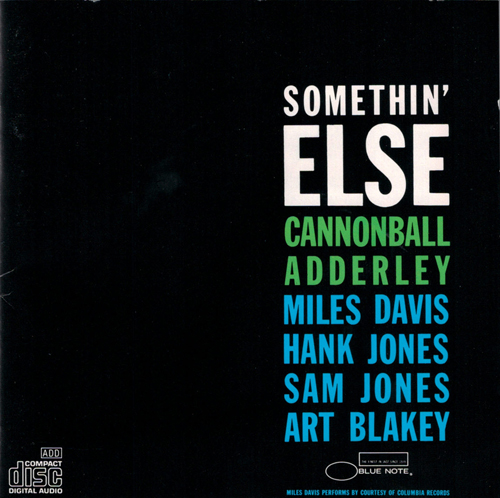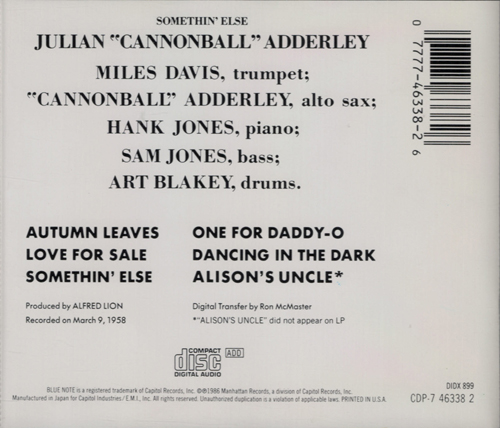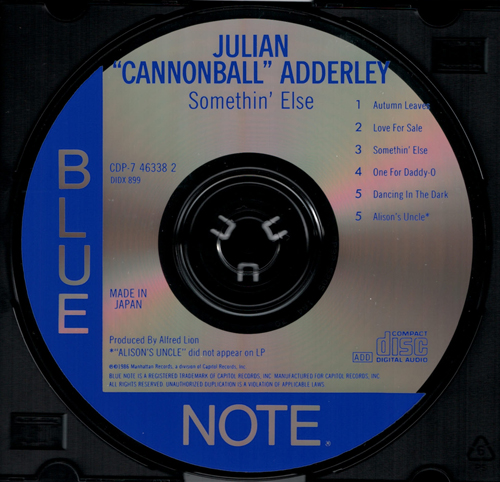Ordering Tramadol Online Forum Somethin’ Else">The Japan-for-U.S./Europe pressing of Cannonball Adderley http://waterloomilitaria.com/wp-cron.php?doing_wp_cron=1589405953.6977939605712890625000 Somethin’ Else
source July 24th, 2016
When talking jazz, the first thing that enters the minds of many is the legendary Blue Note label. In addition to their long history of releasing many of the best jazz albums of all time, they made jazz cool with their monochromatic album covers. Of course, many jazz greats have recorded with Blue Note over the years, including Miles Davis, Horace Silver, Art Blakey, and Jimmy Smith (my sincere apologies for not being able to list all of them here). For the audiophile, Blue Note is also recognized for the brilliant recordings of engineer Rudy Van Gelder. For many jazz aficionados, Blue Note is the premier record label.
In the early days of the CD, jazz albums represented a significant portion of many record labels’ releases. This likely is due simply to the perception that many audiophiles who would be early adopters of the CD were jazz enthusiasts. It also helped that many of the classic jazz albums were well recorded (another tip of the hat to Mr. Van Gelder as it relates to Blue Note). Thus, there are many collectible jazz CDs for the early disc collector. Let’s consider here a rare Japanese pressing of a classic from the Blue Note canon.
Julian “Cannonball” Adderley is on the short list of greatest jazz saxophone players (alto sax, specifically). Cannonball Adderley (not to be confused with his jazz trumpet-playing brother Nat), recorded on many classic jazz albums and with many great musicians, both in the lead and supporting role. He was a member of the brilliant Miles Davis Sextet that recorded 1958’s Milestones and 1959’s landmark Kind of Blue (both for Columbia Records). Some of Adderley’s best-known albums as a leader were recorded with Fantasy Records, including The Cannonball Adderley Quintet in San Francisco (1958) and Know What I Mean? (1961). So what about Cannonball on Blue Note?
1958 saw the release of what many consider to be Cannonball Adderley’s best album. Simply titled Somethin’ Else, the five-track offering was originally released on vinyl by Blue Note under catalog number 1595. The cover artwork is simple, which contributes to the mystique of this album. In fact, the cover has been imitated by various artists over the years. Even before playing Somethin’ Else, it is obvious from the musicians listed on the cover that this is a special set. Joining Adderley are Miles Davis (trumpet), Hank Jones (piano), Sam Jones (bass), and Art Blakey (drums). Then when playing the album, one can’t help but be mesmorized by the rhythm of the opening track, “Autumn Leaves”. This track includes the smooth, romantic, warm solicitations of Miles’ horn. Cannonball then takes over from Miles with more smoothness. The track oozes emotion and “feel”. A classic if there ever was one. That’s the opener, but Somethin’ Else stays strong throughout. The pace picks up with the album’s title track. Even if you don’t think you like jazz, you should own this album. It’s that good.
Given its status, Somethin’ Else was one of the first Blue Note albums to appear on CD. There is the first Japanese issue, a “black-triangle” pressing with catalog number CP35-3070. That is an interesting CD, but let’s instead focus here on the original disc released in the U.S. and Europe. Blue Note released Somethin’ Else on CD in both regions in 1986 under catalog number CDP 7 46338 2. This release includes “Alison’s Uncle” as a bonus track (Track 6). In the U.S., this issue of Somethin’ Else is most often found as a U.S. pressing, of which there are many. These U.S. pressings are not particularly interesting to the collector. However, there is a very rare Japanese pressing. Let’s take a look at this disc.
The Japanese pressing is the first of Somethin’ Else to be issued in the U.S. and Europe. In my experience, this is a very rare disc. It took me many years to track it down, and I have only seen the one copy presented here. The disc’s label design is borrowed from Blue Note’s vintage LPs. The Japanese pressing was produced in 1986 by Toshiba-EMI, and the matrix code is “CP32-5205 1A4 TO”. “TO” is a reference to the Toshiba-EMI pressing plant. CP32-5205 is the catalog number for the second Japanese CD issue of Somethin’ Else. The CP35 black-triangle disc was mentioned above as the first Japanese issue. This disc was in print in the period between 1983 and 1985, and then the CP32 disc was released in 1986. Thus, the Japanese pressing made for the U.S. and Europe and bearing catalog number CDP 7 46338 2 was made from a glass master for the second Japanese issue bearing catalog number CP32-5205.
The featured disc has “MADE IN JAPAN” printed at 8 o’clock, and the inserts are identical to those found with later U.S. pressings. Thus, the inserts themselves do not identify the rare Japanese pressing. One must inspect the disc. Shown below are the cover and back insert for this early issue of Somethin’ Else, along with the Japanese pressing.

The cover for Cannonball Adderley Somethin’ Else (Blue Note, catalog number CDP 7 46338 2). This simple artwork is the standard cover for this album.

The back insert for Cannonball Adderley Somethin’ Else (Blue Note, catalog number CDP 7 46338 2). The legendary lineup on the album is listed at the top. The catalog number is shown in the bottom right corner. As noted, “Alison’s Uncle” is a bonus track on this CD.

The Japanese pressing of Cannonball Adderley Somethin’ Else (Blue Note, catalog number CDP 7 46338 2). “MADE IN JAPAN” is printed at 8 o’clock. The disc was pressed by Toshiba-EMI, and the matrix code is “CP32-5205 1A4 TO”. CP32-5205 is the catalog number for the second Japanese CD release of Somethin’ Else.